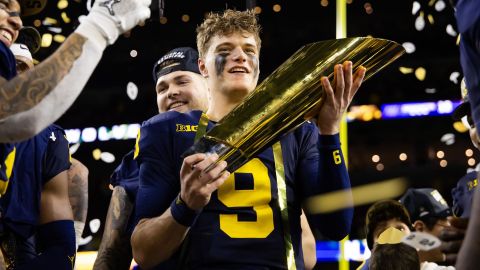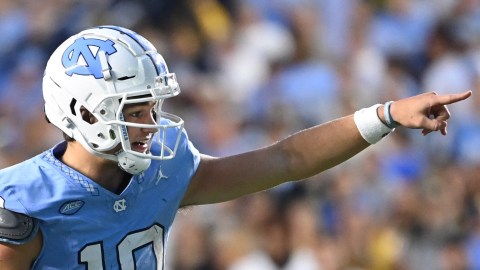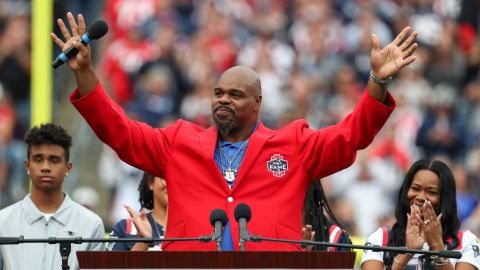FOXBOROUGH, Mass. — Welcome to Wildcat week.
With the Miami Dolphins traveling to Gillette Stadium this weekend, the New England Patriots defense will be forced to immerse itself in full preparations for Miami’s unique offense.
Let’s take a look at the challenge that will be presented to the Patriots, starting with Tuesday’s practice and culminating with Sunday’s game.
What is the Wildcat?
It looked like a gimmick offense that the Dolphins would use sporadically after they busted it out last season against the Patriots. However, it became too successful for the Dolphins to ignore.
In its most basic form, the Wildcat calls for the running back to line up in the shotgun formation and take the direct snap from the center. Ronnie Brown is typically responsible for taking the snaps, and he’ll either run the ball, hand it off to Ricky Williams or — on rare occasions to keep defenses off balance — throw the ball downfield.
Miami came to Gillette Stadium in Week 3 of the 2008 season with an 0-2 record and just one victory in its last 20 games, while the Patriots were riding an NFL-record 21-game regular-season winning streak. The Dolphins shocked the Patriots with six Wildcat plays that resulted in four touchdowns in a 38-13 victory. The Wildcat served as the heart of Miami’s stunning victory, and that in turn led to an improbable AFC East championship.
Offensive coordinator Dan Henning’s masterful game plan blindsided New England’s defense, but the Patriots got revenge during the teams’ second meeting in 2008. Brown took eight Wildcat snaps, but those plays netted just 25 yards.
The stats
The Dolphins have run 460 offensive plays this season, and 66 of those plays (14.3 percent) have come out of the Wildcat formation, according to Miami’s public relations department. Those 66 plays have resulted in 357 yards (5.4 yards per play) and four touchdowns.
By proportion, Wildcat plays amount to 16.7 percent of the Dolphins’ total yardage and 23.5 percent of their touchdowns. Conversely, Miami is gaining 4.5 yards per play — nearly one full yard less — out of conventional offensive formations.
Brown is the primary beneficiary in the Wildcat offense. He has 40 rushes for 232 yards (5.8 yards per carry) and two touchdowns, and he has also completed one of four passes for 21 yards, no touchdowns and no interceptions, and he was sacked once for a loss of nine yards.
Brown’s completion was to tight end Anthony Fasano, who has been targeted by two passes in the Wildcat. Tight end Joey Haynos was credited as Brown’s other two targets, although one of the passes was really just thrown away out of bounds.
Williams has 19 rushes for 95 yards (5.0 yards per carry) and two touchdowns in the Wildcat, and he has not attempted a pass. Patrick Cobbs has two rushes for 18 yards and no pass attempts, but he tore his ACL and is out for the season.
For statistical purposes, the Dolphins are not technically in a Wildcat formation when rookie quarterback Pat White is taking the snaps from the center. White is used in sub-formations in Wildcat-like plays, but his status as a quarterback removes the Wildcat title from plays in which he accepts the snap.
Miami’s options
As difficult as it is to defend the Wildcat, the scheme itself is fairly basic. Keep in mind there is room for other options, but we’ll focus on the primary plays the Dolphins use with the Wildcat.
Brown almost always starts off in the shotgun, and Williams usually lines up as a slot receiver. Brown waves for Williams to motion to the backfield, and the ball is snapped when Williams is close enough to Brown. It’s at this point when the Dolphins break out into one of their variations of the play.
Most important is the dive play, when Brown fakes a hand-off to Williams and then keeps the ball and rushes up the middle. Williams continues running without the ball to the outside of the offensive line, and that temporarily freezes the linebackers, who have to find the ball before they can commit to a running back. Meanwhile, a guard pulls out of his gap and overloads the other side of the line to help open a hole for Brown.
The simple dive play is important for both sides of the ball because it’s Miami’s most frequently used play as well as its most successful play out of the Wildcat. For instance, Brown scored the game-winning touchdown on a dive play in the final seconds against the New York Jets in Week 5. It was predictable, but Miami still found success during the most important play of the game.
Brown can also hand the ball to Williams, who can either take the ball on a sweep to the outside or continue up the middle for a dive. If Williams sweeps, the guard will pull farther to the outside in an attempt to open up a wider hole to run.
To keep defenses honest, Brown can also throw the ball. Because he is left-handed, the Patriots must be on high alert if Brown runs a play outside to the left because he can unload the ball at anytime. Brown can also fake a dive play, pull it back and hit a receiver down the field. All of Brown’s passes this season have gone to tight ends, who have to originally fake as though they are running downfield to engage a linebacker or safety in a block. Once the tight ends (as well as wide receivers) sell the block, they can break out into their passing route.
This play has the biggest boom-bust potential. If the Patriots’ safeties correctly read the play and stay in coverage, Brown is forced to make a tough decision. He’s either got to make a dangerous pass attempt or pull the ball down and try to gain yardage on the ground. However, after spending a few seconds looking down the field at his targets — and the blocks set up for a pass play, rather than a run play — it’s very difficult for Miami to gain anything positive if Brown tries to run as a second option. Brown can also throw the ball away, as he did against the Jets on Sunday.
Expect a surprise
Let’s face it, the Dolphins waited until Week 3 to break out the Wildcat in 2008 because they knew they needed a boost to spark their season. Henning is a great offensive coordinator who is smart enough to know that Bill Belichick has made the proper adjustments to stop the Wildcat. The Patriots proved that in their 2008 rematch, and they’re even more prepared for it this season — as shown when they eventually contained the Denver Broncos’ Wildcat plays in Week 5. At this point, the Patriots should expect that Henning has held something back, and they’ll see something new Sunday.
Practice makes perfect
Before Sunday’s game, the Dolphins have already tallied a small victory against their opponents, who have to spend time in practice preparing for the Wildcat. On one side, it’s got to be a bit annoying devoting practice time to a formation that is only used 14.3 percent of the time. On the other, as the Patriots learned last season, if you can’t defend the Wildcat, you’ll lose in an embarrassing fashion.
“I think the most important thing is that we’re sound on it, and we’re prepared for it,” Belichick said. “If we get it, we at least know how to play it and the different things that come out of it, but they certainly do a lot of other offensive groups, formations and personnel grouping besides that, and we have to be ready for all those. It’s certainly a challenging aspect to the whole preparation process. We want to be able to defend that, but at the same time, we don’t want to commit so much time to it that we don’t do a good job on the other things they do as well.
"Hopefully, we’ll be able to use a little bit of the extra time this week to get those bases covered, but it’s definitely a preparation problem they present."
The Patriots began preparing for the Wildcat in training camp over the summer, so they’ve already put some work in on the matter. Rookie wide receiver Julian Edelman, who played quarterback at Kent State, might have been the scout team’s best option to emulate Brown, but the Patriots have plenty of fast, athletic players who can fill in for the injured Edelman, including rookie wide receiver Brandon Tate, special teamer Matthew Slater or even rookie cornerback Darius Butler, along with running backs Laurence Maroney and Kevin Faulk.
To hit the quarterback, or not to hit the quarterback
It’s often asked: When the quarterback lines up out wide, why doesn’t the cornerback just knock him to the ground? It’d certainly be a nice way to rattle Henne. However, Belichick responded to that question Monday, and it makes sense to leave the quarterback alone.
After all, if the quarterback is lined up as a wide receiver, his primary job will be to block someone. Since quarterbacks block as well as linemen throw, it’s counterproductive for the defense to take Henne out of the play. Doing so would temporarily take the cornerback out of the play, too, leaving one less defender to stop the Wildcat. In actuality, hitting the quarterback would be a small victory for the offense.
"[By hitting the quarterback], you’ve sacrificed a player that you could actually gain into the play because that quarterback is not really a threat to do much blocking," Belichick said. "You’ve given up a player that could actually help you on the other aspects of the play, so that’s probably why most teams don’t do a lot of that."
How to stop the Wildcat
The Patriots’ defense has to play with as much discipline as it will need all season. The linebackers have to attack the gaps in the line, but they can’t over-pursue before targeting the location of the football.
Brown and Williams aren’t speedsters who can change direction and fly to the other side of the field like Tennessee’s Chris Johnson or even New York’s Leon Washington (pre-injury, of course), but the key is identifying who has the ball and where they’re going with it. Otherwise, the blockers will be in position to open it up for a big gain.
Expect the Patriots to use a 3-4 defense to stop the Wildcat because they’ll need their linebackers to break through the line and make some tackles. Gary Guyton’s speed should be a huge asset, as will Jerod Mayo’s ability to read and recognize the play. This could also be a big game for Adalius Thomas, who has experienced the majority of his success by attacking the backfield — and that might be his biggest role against the Dolphins.
And finally, the Patriots need to tackle well. They’ve had some good tackling moments this season, but they’ve also had some bad ones. That is as basic as it gets when trying to stop a team that loves to run the football.
"When you see a team that has multiple personnel groups on offense, you always have to be sharp," said Patriots defensive coordinator Dean Pees. "Our guys have to do a great job of communicating, and obviously tackling is going to be an issue this week, as it is every week. You’re facing two excellent running backs here. It doesn’t matter which one of them has the ball."



